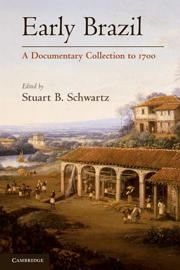Book contents
- Frontmatter
- Contents
- Preface
- A Note on Translation
- A Note on Portuguese Currency, Weights, and Measures
- Maps
- 1 The “Discovery” and First Encounters with Brazil
- 2 The Donatarial System
- 3 Royal Government
- 4 The French Interlude
- 5 Indians, Jesuits, and Colonists
- 6 The World of the Engenhos
- 7 Government and Society in Dutch Brazil
- 8 Burdens of Slavery and Race
- 9 Public and Private Power
- 10 Religion and Society
- 11 Frontiers
- Index
7 - Government and Society in Dutch Brazil
Published online by Cambridge University Press: 05 June 2012
- Frontmatter
- Contents
- Preface
- A Note on Translation
- A Note on Portuguese Currency, Weights, and Measures
- Maps
- 1 The “Discovery” and First Encounters with Brazil
- 2 The Donatarial System
- 3 Royal Government
- 4 The French Interlude
- 5 Indians, Jesuits, and Colonists
- 6 The World of the Engenhos
- 7 Government and Society in Dutch Brazil
- 8 Burdens of Slavery and Race
- 9 Public and Private Power
- 10 Religion and Society
- 11 Frontiers
- Index
Summary
Portugal was ruled by the Spanish Hapsburgs from 1580 to 1640. During that period, it profited from the advantages of new markets and opportunities in Spain and its empire, but its commerce and colonies also became a target for Spain's enemies. The rebellious provinces of Holland formed the Dutch West India Company in 1621 to aid in the political and economic struggle against the Hapsburg Crown. Portugal and its colonies and commerce, now ruled by the Spanish Hapsburgs, became prime targets for the Dutch. Pernambuco and subsequently much of the northeastern coast of Brazil were captured after 1630; the Dutch created their own colony in northeastern Brazil and held it until they were expelled in 1654. The report included here provides an overview of that colony during the years in which the Dutch, under the able direction of Governor Johann Maurits von Nassau, sought to make the Brazilian colony a success by extending religious toleration to Catholics and Jews.
(From José Antônio Gonsalves de Mello, ed., Fontes para a História do Brasil Holandês, 1. Economia Açucareira [Recife, 1981], pp. 96–129.)Government by the Dutch
His Excellency Johan Maurits, Count of Nassau, as governor-general, captain and admiral-general, together with the noble members of the High and Secret Council, acting on behalf of their High Powers, the States-General of the United Netherlands, of His Highness the Prince of Orange, and of the noble directors of the General West India Company, constitute the supreme government of those areas of Brazil that have already been conquered or that will be conquered in the future. To them is subordinated the Board of Political Counsellors, which was established to administer justice.
The aforesaid Board of Political Counselors, which should consist of nine members, is at present greatly under strength, with insufficient counselors to conduct its business. Heer Ippo Eysens was killed in October 1636 in Paraíba; Heer Cornelis Adriaensz Jongknecht has also died, just after his return from an expedition to the south; and shortly afterwards, Heer Johan Robbertsen died at Cape Santo Agostinho. Heer Jacob Stachhouwer has become a private citizen, Heer Paulus Seroskerchen has obtained permission to return to the Netherlands, and finally Heer Hendrick Schilt has been dismissed from office. There are currently only three political counselors, namely Heeren Willem Schot, Balthasar Wyntgis, and Elias Herckmans. The last-named has to date been living in Paraíba, of which he is director, and consequently has been unable to attend meetings of the board. Heer Wyntgis used to live on [the island of] Itamaracá as director of that captaincy, but, owing to the board's reduced numbers, we have commanded him to take up residence here, in order to accompany Heer Willem Schot in the exercise of justice. We have appointed a number of assistant counselors to work alongside these counsellors in dealing with criminal matters and with other issues of major importance. Nonetheless, judicial and other concerns, which are the very purpose for which the college exists, are not being exercised as they should be, and as is so necessary for the good of the settlers.
- Type
- Chapter
- Information
- Early BrazilA Documentary Collection to 1700, pp. 234 - 263Publisher: Cambridge University PressPrint publication year: 2009



